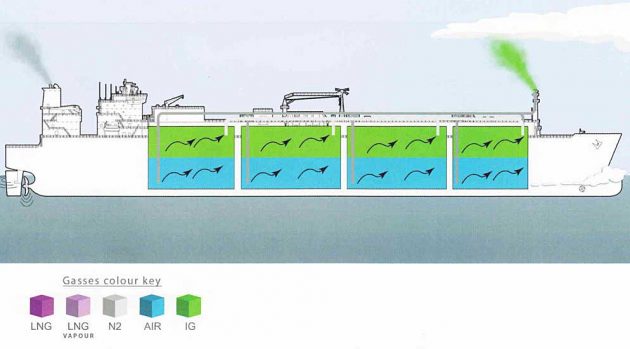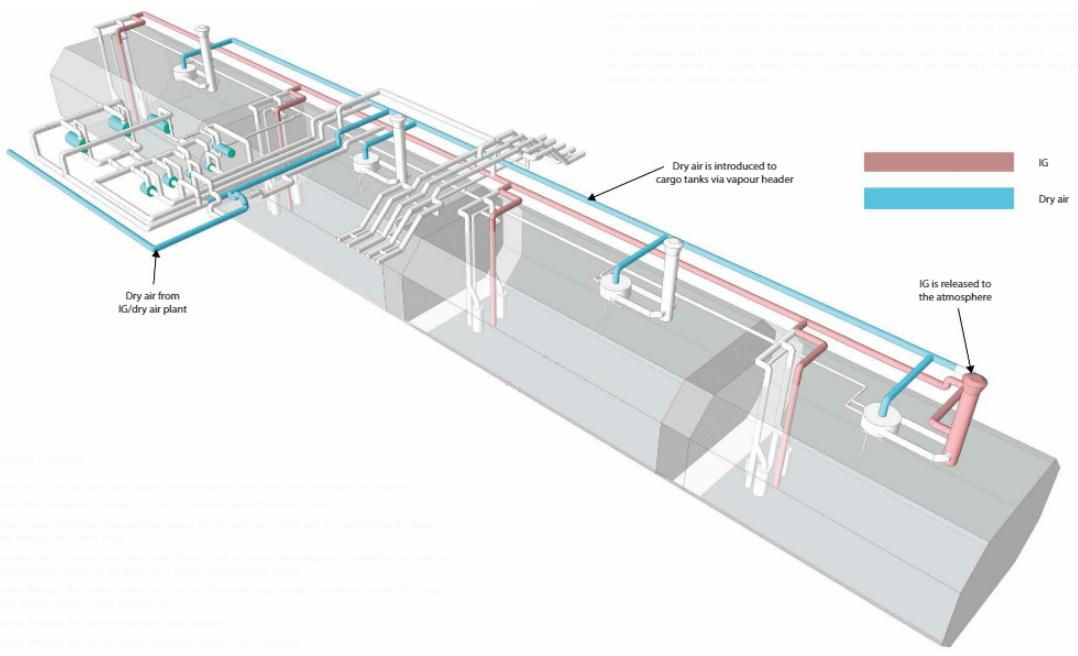Learn everything you need to know about LNG tank aeration on LNG carriers. This comprehensive guide covers the entire process, including an overview of aeration, preparation steps, a detailed operational description, and important considerations for safe and efficient cargo tank aeration. Ensure your LNG carrier operations are top-notch with our expert insights and best practices.
Reference: SIGTTO “LNG Shipping Suggested Competency Standards”, Sections:
1 Have an awareness of the principles of aeration:
- the method to be used to change tank atmosphere.
2 Know and understand the procedures for aeration:
- operation of inert gas generator to supply dry air of appropriate quality;
- line-up of cargo system to purge cargo tanks;
- line-up and procedures to purge pipelines;
- criteria to be monitored during and upon completion of the operation;
- vapour pressure:
- likely behaviour;
- precautions during pressure control via vent mast.
Aeration of cargo tanks. Overview
Why cargo tanks aeration is important procedure?
Before any personnel can enter the cargo tanks, the inert gas (IG) must be replaced with dry, breathable air and a gas free certificate issued. This should include the pipelines (liquid and vapour), cargo machinery and associated heat exchangers and fittings. It is a good practice to leave the IG plant running in aeration mode until the gas free certificate is issued.
Testing for traces of noxious gases (including CO2 < 0,5 % by volume and CO < 50 ppm) that may have been constituents of the IG will be carried out, by shore staff at sea and by a shore chemist prior to refit, before a gas free certificate is issued.

The company SMS will outline tank entry procedures. Appropriate precautions as outlined in ISGOTT and other relevant publications must be taken. With the IG/dry air plant in dry air production mode, purge the cargo tanks with dry air. The aeration operation will take about 20 hours.
The operation is complete when all the tanks have an O2 content of 20,9 %, a CH4 content < 50 % of LEL (2 % of volume) (or a locally required equivalent) and a dew point < minus 40 °C (-40 °C).
Preparation for aeration
- A detailed plan of the operation must be prepared;
- measuring devices (Complete Manual for Engineers about Dew Point Reservoirsdew point meters and portable gas detectors) must be checked and calibrated prior to operation;
- prepare the IG/dry air plant for use in the dry air mode;
- in preparation for aerating, it will be necessary to fit the relevant spool pieces;
- line up the IG/dry air line to the vapour header;
- line up the liquid header to No. 1 vent mast.
Line up of the cargo piping must be as per the ship specific cargo operating manual. Typically, it will be as follows:
- open the valves to supply dry air to the vapour header;
- open the tank filling valves;
- open the tank vapour valves.
Operational description – cargo tank aeration
The procedure is as follows:
- start the IG/dry air plant, discharging to atmosphere until the correct dew point is obtained;
- when the dew point is minus 45 °C (-45 °C) or lower, open the valve to deck;
- flow is now established through the vapour line of LNGC Project Factors and Cargo Containment Systemeach cargo tank and IG is vented via the liquid line through No.1 vent mas;
- monitor the O2 content and dew point of each tank by taking a reading with a portable gas detector and dew point meter at the liquid and vapour dome sample points;
- purge through the sample valves and lines on the main cargo pumps. emergency pump discharge, float gauge column, radar still pipe, etc.;
- purge through the spray header and spray pumps;
- purge through the compressors, vaporisers, heaters and manifolds;
- where there are blank flanges, these should be slackened off to allow the section of the line to be property aerated;
- when the O2 content measured in the cargo tanks is 20,9 % by volume and the values of CH4, CO and CO2 are at prescribed levels, close the filling and vapour valves (change over dry air flow to atmosphere);
- when all the tanks are aerated, stop the IG/dry air plant (if before refit, this will not normally be until the shore chemist has issued the gas-free certificate);
- close the supply valve to the vapour header and close the venting system at the vent mast.

Further considerations
Cargo tanks are not opened when this stage is completed. During the dry-dock preparations, tank entry can only occur after the shore chemist has tested/passed all associated spaces and issued a gas-free certificate.
Read also: Preparation of loading and unloading operations for LNG/LPG carriers
On membrane type LNGCs, differential pressure across the barriers, both primary and secondary, must be maintained within acceptable limits. Prior to opening cargo tanks, the pressure in the barriers may be required to be in vacuum (e. g. NO96).
